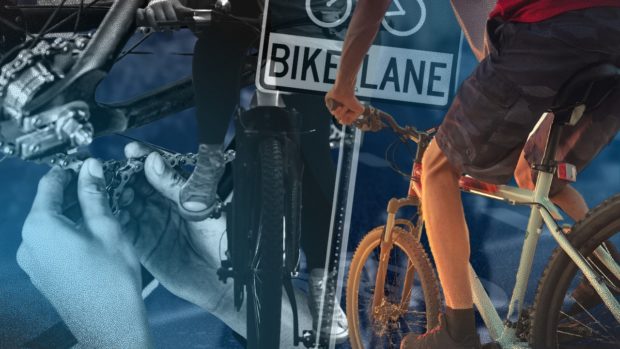MANILA, Philippines—While there are various reasons people use bicycles, “people on bikes” need the same thing—investments in infrastructure for active transport.
This was the reason the Mobility Awards conducted a Bike Count Program, stressing that “investments in active transport infrastructure is best justified when anchored on regularly collected and analyzed data.”
Aldrin Pelicano, MNL Moves founder and Institute for Climate and Sustainable Cities inclusive mobility advisor, said the program was “our response and contribution to the continuing challenge over the lack of bike traffic data.”
RELATED STORY: Pandemic shows why Metro Manila needs more, better bike lanes
Conducted in 10 cities—Quezon, Marikina, Pasig, San Juan, Baguio, Naga, Cebu, Mandaue, Iloilo, and Davao—the program, which mobilized 600 volunteers, recorded 191,578 “people on bikes.”
The Mobility Awards said the collected data will provide urgency and basis for the government to accelerate the establishment of safer, more inclusive infrastructure and policies promoting active transportation.
“Apart from local governments, many stakeholders can use the bike count data in improving their policies and programs, including the business sector and the academe,” said Metro Naga Active Transport Community organizer Ramon Dominic Nobleza.
As stated in the findings of the Bike Count Program, most “people on bikes” were recorded in Cebu City at 42,995—89.24 percent were male, 3.58 percent were female, and 7.18 percent were not determined.
Next to Cebu City were the cities of Naga (35,223), Mandaue (25,765), Iloilo (22,114), Quezon (22,010), Pasig (16,238), Marikina (11,783), Davao (9,065), San Juan (4,053), and Baguio (2,332).
This year’s count was conducted in 99 different locations across 10 cities in peak hours—morning (5 a.m. to 7 a.m. in Metro Manila, 6 a.m. to 8 a.m. in the remaining cities) and afternoon (4 p.m. to 7 p.m.)
The Bike Count Program was first initiated in Metro Manila last year, where 168 volunteers recorded 38,932 people on bicycles, 1,658 personal mobility device users, and 12,787 pedestrians in Pasig, San Juan, Marikina, and Quezon City.
As stressed, however, by the Mobility Awards, the report likewise found a “huge gap” between the number of male and female cyclists, with females accounting for only 3.83 percent of the total.
The percentage of helmet users and non-helmet users, meanwhile, were almost equal at 51.43 percent and 48.57 percent, respectively.
Based on data, out of the 2,332 “people on bikes” in Baguio City, 93.67 percent are helmet users while only 6.33 percent are non-helmet users. Iloilo City has the highest percentage of non-helmet users at 82.84 percent.
Gains of cycling
As stressed by Pelicano, the 191,578 bike traffic volume is still a “significant undercount,” saying that “we need permanent count programs that use appropriate technologies to ensure we capture up to date data.”
READ: PH pandemic produced more bikers, rise in bicycle road crashes
The Mobility Awards said the count of “people on bikes” on main roads translates to every day fuel cost savings ranging from P147,000 to 307,000 per kilometer, “which are compelling figures given the continuing rise in fuel prices in the Philippines.”
Likewise, Pelicano said the 191,578 bike traffic volume also prevented at least 4.46 tons of carbon dioxide emissions, which he stressed is significant given the demands of scientists and environmentalists to lessen emissions.
“What was great in doing this bike count is that it empowers people, and it ensures that people are accounted for. This bike count has provided the conclusion that there is power in people to exercise their right to quality travel,” said Nobleza.
“What kind of quality? Pro-people, safe, and inclusive,” he stressed.
To recall, The Bike Count Program is a citizen-led effort spearheaded by the convenors of the Mobility Awards, namely ICSC, The Climate Reality Project Philippines, MNL Moves, 350.org Pilipinas, and Pinay Bike Commuter Community.
RELATED STORY: World Car-Free Day: A glance at greener, safer roads for people
Biking way to convenience
Based on a recent survey conducted by the Social Weather Stations, 29 percent of Filipino households, which translates to an estimated 7.3 million people, are using bikes—23 of which used bikes that they own while six percent used bikes that they borrowed.
Likewise, the survey found that there were more bicycle owners than car owners nationwide. The ratio of bike-to-car owners was 5:1 in Metro Manila, 4:1 in areas in Luzon outside Mega Manila, 2:1 in Visayas, and 3:1 in Mindanao.
Bicycles, as stated by the respondents, are being used for essential (21 percent) and recreational purposes (18 percent). The 7.3 million is higher than the 6.2 million last year. Non-cycling households, meanwhile, fell to 18.2 million from 19 million.
Looking at the result of the Bike Count Program, Nobleza said Bicol has one of the lowest minimum wages in the Philippines at P365, so laborers and construction workers use bikes instead to save money.
RELATED STORY: Suffering commuters, higher fare, fewer trips: PH transport woes pile up
“These are the stories that we see through these numbers,” he said.
Gov’t response
The Department of Transportation (DOTr) had said part of its 2023 budget is allocated for the procurement and installation of automated traffic count instruments in Metro Manila, Cebu, and Davao, with the aim to gather hourly, daily, and monthly statistical data on the use of bike lanes.
The department also targets to count people in personal utility devices and pedestrians, apart from “people on bikes.”
“In DOTr, we always welcome and very much appreciate this bike counting initiative, especially focusing on sustainable modes of transport, which is very long overdue in the Philippines,” Eldon Dionisio, project manager of the DOTr Active Transport Program Management Office, said.
RELATED STORY: Sensible public transport: A post-pandemic dream
“The findings serve as an undebatable evidence for lawmakers and government officials on the urgent need to prioritize active transport projects and policies.”
To recall, the government allotted P1.3 billion under the Bayanihan to Recover as One Act to build a 522.73- kilometer bike lane network along national roads. So far, over 500-kilometer bike lane networks have been completed.
